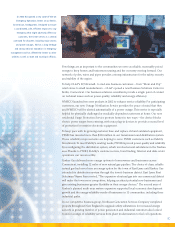Eversource 2002 Annual Report Download - page 20
Download and view the complete annual report
Please find page 20 of the 2002 Eversource annual report below. You can navigate through the pages in the report by either clicking on the pages listed below, or by using the keyword search tool below to find specific information within the annual report.
18
PSNH funded its capital expenditures through internally generated
cash flows and through proceeds returned from NAEC as a result of
the sale of Seabrook. PSNH returned $37 million of equity capital to
NU in 2002. PSNH’s capital expenditures are expected to total $116.3
million in 2003 and remain largely funded through internally generated
cash flows.
WMECO has applied to the Massachusetts Department of
Telecommunications and Energy (DTE) to refinance approximately
$100 million of short-term and spent nuclear fuel obligations. A decision
is expected in the first half of 2003. CL&P also is considering refinancing
approximately $200 million of spent nuclear fuel obligations in 2003.
Competitive Energy Subsidiaries: In November 2002, NU renewed its
$350 million credit line for the competitive energy subsidiaries, under
terms similar to the arrangement that expired in November 2002.
A previous credit line had provided up to $300 million for the competitive
energy subsidiaries. There were $49 million in borrowings on this credit
line at December 31, 2002, and Select Energy had approximately $6.7
million in letters of credit outstanding to provide credit assurance for
wholesale power transactions.
NU’s competitive businesses have minimal capital expenditures. NGC’s
capital expenditures totaled $16.4 million while HWP’s totaled $1 million
and other capital expenditures totaled $5.8 million in 2002. In July
2002, NU’s competitive energy subsidiaries acquired certain assets
and assumed certain liabilities of Woods Electrical Co., Inc. (Woods
Electrical), an electrical services company, and Woods Network
Services, Inc. (Woods Network), a network products and services
company, for an aggregate adjusted purchase price of $16.3 million
(collectively Woods). NU made no other business acquisitions in 2002.
Consolidated Edison, Inc. Merger Litigation
On March 5, 2001, Consolidated Edison, Inc. (Con Edison) advised NU
that it was unwilling to close its merger with NU on the terms set forth
in the parties’ October 13, 1999 Agreement and Plan of Merger, as
amended and restated as of January 11, 2000 (the Merger Agreement).
On March 12, 2001, NU filed suit against Con Edison in the United
States District Court for the Southern District of New York (the District
Court) seeking damages in excess of $1 billion arising from Con
Edison’s breach of the Merger Agreement.
On May 11, 2001, Con Edison filed an amended complaint seeking
damages for breach of contract, fraudulent inducement and negligent
misrepresentation. Con Edison has claimed that it is entitled to recover
a portion of the merger synergy savings estimated to have a net present
value of in excess of $700 million. NU disputes both Con Edison’s
entitlement to any damages as well as its method of computing its
alleged damages.
The companies have completed discovery in the litigation. Motions for
summary judgment were argued before the District Court on February 4,
2003. No trial date has been set. At this stage of the litigation, management
can predict neither the outcome of this matter nor its ultimate effect
on NU.
For further information regarding this litigation, see NU’s 2002 report
on Form 10-K, Item 3,“Legal Proceedings.”
Implementation of Standard Market Design
On March 1, 2003, the New England independent system operator
(ISO) implemented a new Standard Market Design (SMD). As part of
this effort, locational marginal pricing (LMP) will be utilized to assign
value and causation to transmission congestion. Transmission congestion
costs will be assigned to the load zone in which the congestion occurs.
Those costs are now spread across virtually all New England electric
customers. In addition, the implementation of SMD will impact wholesale
energy contracts with respect to the energy delivery points contained
in those contracts.
Regulated Utilities: Connecticut has been designated a single load
zone. Due to the transmission constraints and inadequate generation,
Connecticut could experience significant additional congestion costs
under SMD. The New England ISO estimates that the costs of
transmission congestion for 2003 in New England under SMD will
range between $50 million and $300 million. The New England ISO
estimates that the majority of this congestion and its costs will be in
Connecticut, where approximately 80 percent are expected to be paid
by CL&P beginning on March 1, 2003. CL&P believes that under the
terms of its standard offer service contracts with its standard offer
suppliers these costs are its responsibility. The contracts with the standard
offer suppliers expire on December 31, 2003. In addition, the determination
of the energy delivery points associated with the standard offer service
contracts under SMD could also produce significant costs for CL&P
that management cannot determine at this time.
Another factor affecting the level of congestion costs is the designation
of certain generating units by the New England ISO as units needed
for system reliability. Some of the companies owning these units have
applied to the Federal Energy Regulatory Commission (FERC) for
“reliability must run”(RMR) treatment. RMR treatment allows these
units to receive cost of service-based payments that recognize their
reliability value. Prior to March 1, 2003, all RMR costs were spread
across New England with all utilities being billed by the New England
ISO based upon their share of New England’s load. NU’s regulated
electric utilities were responsible for approximately 25 percent of these
costs. Effective with the March 1, 2003 implementation of SMD by the
New England ISO, RMR costs will be allocated to the load zone in
which the RMR unit is located. At present, the only load zone that will
experience a cost increase in which a NU regulated electric company
operates is Connecticut. With respect to the Connecticut load zone,
there are two generating units operating under a RMR contract with an
additional contract pending before FERC. These contracts are for one
year terms, and one contract contains an extension option. On a
combined basis, these two RMR contracts will result in an annual cost
of approximately $45 million to the Connecticut load zone. CL&P
accounts for approximately 80 percent of the Connecticut load zone,
and would be responsible for approximately $36 million of this cost.
In the near future, it is probable that there will be significant new
requests for RMR treatment in Connecticut which, if approved by
FERC, would add significant additional costs to the total cost of energy
in Connecticut. However, generating units operating under RMR contracts
could potentially mitigate the overall level of congestion costs.
























